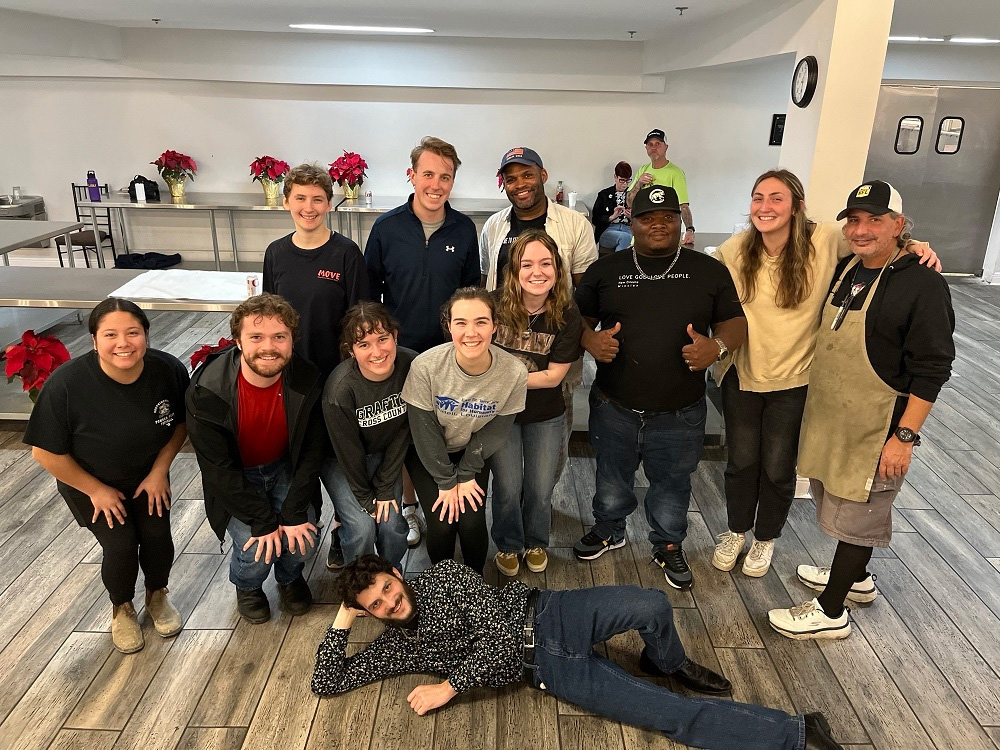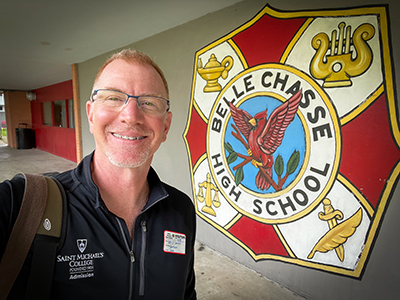Veteran’s garden research both academic and practical
Last year when he began working with fellow veterans and other community partners in the Saint Michael’s College organic garden, Chris Boutin ’18 knew he was onto something – but he wasn’t sure exactly what the next year’s full outgrowth might be.
This past week that “something” came into sharper focus when the Marine veteran and psychology major on July 21 presented results of his summer mentored research project: to construct a social and therapeutic horticulture therapy program for veterans at Saint Michael’s at the garden/Permaculture site. “It’s really more an education and community service program, but structuring it the way we did builds in horticulture therapy without the idea that all participants necessarily would need that therapy,” Boutin said.
He developed his plan under the guidance of faculty research adviser Kristyn Achilich ’05, academic program coordinator of the organic garden and permaculture site at the College, based on a comprehensive literature review and his own experiences. He’s been deeply involved in the garden for more than a year.
Boutin touched on both the practical and the academic in Friday’s presentation to a small group that first met with him in the garden down the hill behind the Observatory before moving to the Office of Military Community Services in Klein Hall for more extended questioning and conversation concerning his “executive summary” on the Vermont Veteran’s Gardening Initiative (VGI).
Along with Achilich, that group included community partners Megan J. Humphrey of the local group HANDS (Helping and Nurturing Diverse Seniors), a small non-profit she founded to fill some gaps in providing food to older adults in Vermont; Jessica Hyman, executive director of Vermont Community Garden Network; Nic Thornbro, a 2016 Saint Michael’s graduate and Army veteran who now works for Vermont Veterans Outreach as an outreach specialist; and Ken O’Connell, the College’s coordinator of military community services and an Army veteran.
Achilich pointed out that, unlike many summer student researchers, Boutin was writing for two distinct audiences: academics in his role as a psychology student, and the garden’s community stakeholders who were more interested in the practical ramifications of the work in plainer language. Boutin oscillated between the two as he sought feedback for revisions. His primary presentation will be to peers at the Academic Symposium next spring.
At the garden site he shared design aspects he proposes for a “passive garden” and shade shelter that he believes will benefit veterans who come to garden, based on his reading of literature about what has worked well elsewhere. Key elements, he said, were making it a “passive setting” for vets to use, which he would create by cleaning out an area near the garden, building a small fire pit for burning brush and a establishing a sitting area, with a pollinator site and bird bath to attract butterflies and birds, along with a bench for veterans to sit and a backstop to create privacy. A nearby shade structure would offer a peaceful view of the entire garden, he said, noting that the literature he read stressed the importance of allowing for a feeling of physical and personal security at such sites.
He said horticulture therapy sites more typically would be at hospitals or rehab centers, where it easier to coax participants to the sites since military veterans are accustomed to being told what do, and when and where to do it. One of the challenges he has encountered, Boutin said, as discussed with the group later at Klein, has been sustaining interest among veterans so that a core group regularly will come to participate.
Other key findings in his research, he told the group, include the need for structured meeting days, the possibility of both group and individual work, active and passive garden elements, exercise, and empowering gardeners to form meaningful relationships in leisure activities. Core values and outcomes for the program he envisions, Boutin concluded, were social inclusion, decreased depression, enhanced quality of life, improved self-esteem and social function.
He outlined the program structure that he envisions around four elements: a garden curriculum – for instance, local expert Charlie Nardozzi offered classes at the garden last year; encouragement that participants create “Gardeners’ Individual Plans” so they can take ownership of their recovery or development; observations by Veterans Administration (VA) staff facilitators, and a support system with the stakeholders.
Beyond increasing participation, challenges raised by those at the meeting included transportation to and from the site, ensuring food safety, and the likely potential for bureaucratic hassles. Based on his military experience and knowledge of veterans’ culture, Thornbro in particular offered a practical and direct voice to the meeting, zeroing in most forcefully on the proposed VA role and accessibility issues.
Achilich said it was important from the College’s perspective that the program have a strong educational element, alongside the desirable service element of providing fresh food to local veteran residential sites. She stressed that the educational element is indispensable. Those gathered agreed to continue working together on all the issues raised.





